The best grouping of teaching when the students are given the task to work out answers to a reading comprehension is__________.A.one-to-one B.groupwork C.pair-work D.solowork
题目
B.groupwork
C.pair-work
D.solowork
相似考题
更多“The best grouping of teaching when the students are given the task to work out answers to a reading comprehension is__________.”相关问题
-
第1题:
When students are asked to find out the changes of their hometown and make a plan for anexhibition, which type of the following grouping methods is mostly recommended
A.Whole class work.
B.Group work.
C.Pair work.
D.Individual work.答案:B解析:考查课堂活动的分组方式。课堂教学中常见的学生分组方式包括四种:全班活动、小组活动、结对活动和个人活动。每一种分组方式都有其优点和缺点,不同的分组方式适用的活动类型不同。全班活动(whole class work)就是需要全班同学共同参与的学习活动。展示型的活动通常采用全班活动的组织形式。小组活动(group work)就是将学生分成若干小组.通过小组内成员的相互配合来完成学习任务的活动。单词游戏、小品表演、项目作业、访谈等都可以采用小组活动形式。结对活动(pair work)是由两个学生进行的活动,需要两个人协作完成。复述练习、对话练习等可以采取结对活动。个人活动(individual work)是学生独立完成的活动,主要用于锻炼学生自主学习能力。单项操练性活动如填空、选择、默读等一般采用个人活动。题干中老师让学生找出家乡的变化并制定展览计划属于项目作业.宜采用小组活动形式。 -
第2题:
根据下面资料,回答
Reading aloud and silent reading are two different types of reading practice. Each has a function in the teaching of reading and should not be 16 by the other. However, we need to be aware when we should use them. When we 17 teaching reading or developing reading skills, we are mostly referring to silent reading. To develop 18 readers in a foreign language, silent reading activities must be given enough 19 and time in class with the proper guidance from the 20 . Reading aloud also has its particular 21 for our students who are learning English as a foreign language. 22 can help them acquire good pronunciation and intonation, 23 them with new words and the stress patterns of English, help 24 their eontidenee in speaking the language. Therefore, opportunities should be 25 for students to read aloud only after they have comprehended the text 26 before comprehension can be very 27 and it can easily destroy their self-confidence. With 28 reading, it sets up a poor reading model for other students as well. It is 29 that we first help students learn the text through 30 reading activities and then with comprehension we give our students practice by using an audio tape to 31 a good model for practicing reading aloud. With adequate 32 , we may ask the students to read aloud to the whole class to 33 their motivation and confidence. By asking the students to read aloud, it is also a good chance for the teacher to get 34 on the students′ comprehension as we can notice 35 there are wrong pauses or mispronounced words which indicate possible difficulties or misunderstanding of the text.
第(34)题选A.suggestion
B.feedback
C.promotion
D.inspiration答案:B解析:考查名词辨析。suggestion“建议”,feedback“反馈”,promotion“提升”,inspiration“灵感”。这里指的是大声朗读也能够让教师从学生的理解中获得反馈。故选B。 -
第3题:
根据下面资料,回答
Reading aloud and silent reading are two different types of reading practice. Each has a function in the teaching of reading and should not be 16 by the other. However, we need to be aware when we should use them. When we 17 teaching reading or developing reading skills, we are mostly referring to silent reading. To develop 18 readers in a foreign language, silent reading activities must be given enough 19 and time in class with the proper guidance from the 20 . Reading aloud also has its particular 21 for our students who are learning English as a foreign language. 22 can help them acquire good pronunciation and intonation, 23 them with new words and the stress patterns of English, help 24 their eontidenee in speaking the language. Therefore, opportunities should be 25 for students to read aloud only after they have comprehended the text 26 before comprehension can be very 27 and it can easily destroy their self-confidence. With 28 reading, it sets up a poor reading model for other students as well. It is 29 that we first help students learn the text through 30 reading activities and then with comprehension we give our students practice by using an audio tape to 31 a good model for practicing reading aloud. With adequate 32 , we may ask the students to read aloud to the whole class to 33 their motivation and confidence. By asking the students to read aloud, it is also a good chance for the teacher to get 34 on the students′ comprehension as we can notice 35 there are wrong pauses or mispronounced words which indicate possible difficulties or misunderstanding of the text.
第(26)题选A.apart from
B.as well as
C.instead of
D.better than答案:C解析:考查短语辨析。apart from“除此之外”,as well as“也,又”,instead of"‘代替”,better than“胜于”。大声朗读应该是在理解课文之后而不是在理解之前,故选C。 -
第4题:
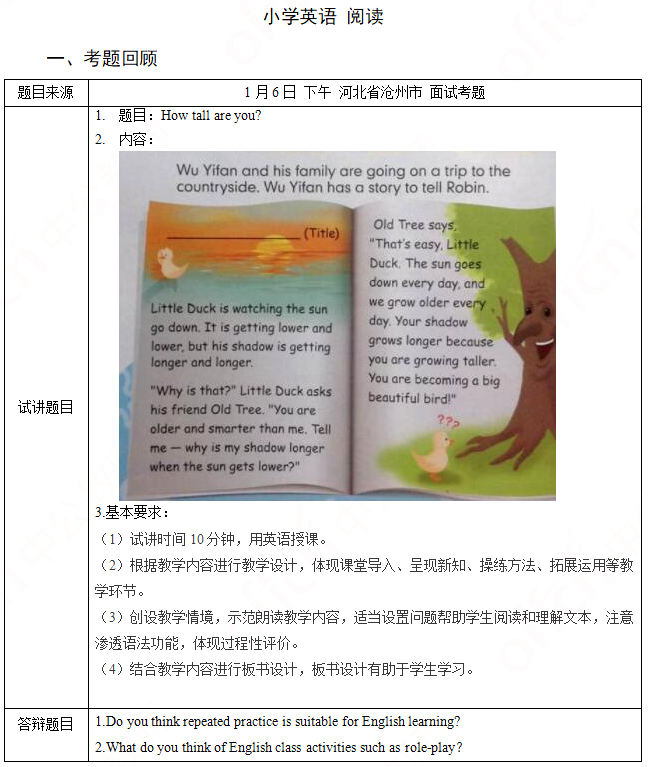
二、考题解析
【教学设计】
Teaching aims:
Knowledge aims:
Students will know about the relation between shadow and the sun through reading the passage.
Students will master the usage of comparative degree in the reading.
Ability aim:
Students will apply the comparative degree to retell the story.
Emotional aim:
Students will be more interest in learning English.
Key and difficult point:
Key Point: Students will master the usage of comparative degree in the reading.
Difficult Point: Students will apply the comparative degree to retell the story.
Teaching procedure:
Step 1: Warming-up
1. Greetings.
2. Play a riddle--it rises up and goes down every day, what is it? and students guess it’s the sun, then lead to the story about the sun.
Step 2: Pre-reading
According to the word “sun”, students have a brainstorm about what natural phenomenon about sun they have known.
Step 3: While-reading
1. Fast reading: students read the passage fast and figure out what the tree and the duck are talking about.
2. Careful reading: students read the passage carefully and answer the question: why does the shadow get longer when the sun gets lower? And underline the words with “er”.
3. The teacher explains the words with “er” to the students.
Step4: Post-reading
1. Students work in pairs to make a role-play (one is the little duck, the other is the old tree) to make a conversation according to the passage.
2. Students work in groups to find the real reason why the shadow gets longer when the sun gets lower.
Step5: Summary and Homework
Summary: ask a student to conclude the content of the lesson and summarize with the whole class.
Homework: students tell the story to their parents.
Blackboard design:

1.Do you think repeated practice is suitable for English learning?
2.What do you think of English class activities such as role-play?答案:解析:1.
Reciting is a way of practicing. There is a gap between understanding English and using English. For students, even if they think they can remember what they learn in class, after class while applying the knowledge taught in class, it possibly doesn’t work very well. So it is a practice way but we can not only use it. We need to use more practice ways together reciting to ensure the effect of teaching and learning.
2.
English class activities play an important role in English teaching. These performances can stimulate students' interest in learning English, mobilize students' enthusiasm for learning English, activate classroom atmosphere, reduce students' learning pressure, help students overcome fear of English learning, cultivate students' participation awareness, cooperation spirit and leadership ability. -
第5题:

二、考题解析
【教案】
Teaching Aims:
Knowledge aim: Students will master some new words like“hybrid rice”and some phrases like “be satisfied with”.They can also know more information about Dr Yuan.
Ability aim: Students acquire the skills of reading and can get the main or detailed information easier than before.题目来源于考生回忆
Emotional aim: Students will understand the importance of agriculture and don’t waste any rice anymore.
Teaching Key Points:
Students understand the whole passage clearly and get some useful expressions that they can apply to their daily life.
Teaching Difficult Points:
Students can be inspired by the devotion of Dr Yuan, as a result they would like to do something useful for all the people in the future.
Teaching Methods:
Communicative teaching method, task-based teaching method, situational teaching method.
Teaching Aids:
PPT, Blackboard and so on
Teaching Procedures:
Step 1: Warming up题目来源于考生回忆
1.Greetings
2.Lead in:read a poem and let’s free talk. The teacher asks students two questions.
Poem:The peasant’s lot—Farmers’ weeding at the noon, sweat down the field soon. Who knows food on a tray, due to their toiling day.
——Do you know the steps of how to grow rice?
——What do you think would happen if tomorrow there was suddenly no food to eat?
Step 2: Pre-reading
1.Background: show students pictures about the farming steps: plowing, seeding, fertilizing, irrigating, transplanting and harvesting.
2.Prediction:do you know who is the most famous person of agriculture in China?
3.Show some new words in this reading materials that students hardly to understand.
Step 3: While-reading
1. Global reading: find out the main idea of the passage and each paragraph.
—multiple choice:which of the following statements tells the main idea of the text?
—match game:match the following main ideas with the right paragraph.
2、Extensive reading: find out detailed information paragraph by paragraph.
Paragraph 2:put the following sentences in right order.题目来源于考生回忆
Paragraph 3:find out the personalities and hobbies about Dr Yuan and fill in the blanket.
Step 4: Post-reading
Retelling: ask students to retell what does the passage talk about in his or her own words.
Discussion: let students think about what can we learn form Dr Yuan.
Step 5: Summary & Homework
Summary : students look at the blackboard and summarize this class.
Homework:students introduce Dr Yuan to their friends in English and try to find more famous people in agriculture.
Blackboard design:
 答案:解析:暂无解析
答案:解析:暂无解析 -
第6题:
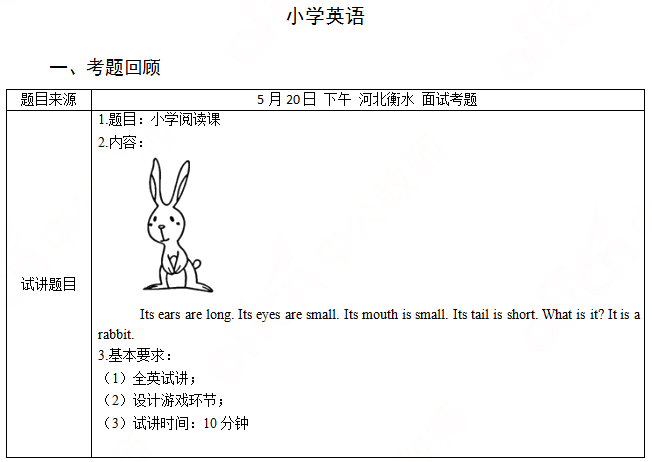
二、考题解析
【教案】
Teaching Aims:
Knowledge aim: Students will master the words “long, small,short, ears, eyes mouth,tail...”
Ability aim: Students can get the key information about rabbit and use the words to describe other animals.
Emotional aim: Students will improve their interest in English.
Teaching Key Points:
Students can understand the meaning of the words“long, small short” and use them to describe other animals.
Teaching Difficult Points:
Cultivate students awareness of loving animals and protecting animals.
Teaching Methods:
TPR teaching method, Communicative teaching method, task-based teaching method.
Teaching Aids:
Pictures, Blackboard and so on.
Teaching Procedures:
Step 1: Warming up
1.Greetings
2.Let students guess a riddle about rabbits. (Teacher need to make some actions to help students guess the answer- rabbit) and then lead in the topic “A rabbit”.
Step 2: Pre-reading
1. Show Students different pictures of rabbits to let students discover the common points.
2. Invite two students to try to describe rabbits in their own words.
3. Teach students these words “ tail, mouth ,ears,eyes”
Step 3: While-reading
1.Let students read the sentences and circle the words that are used to describe rabbits and invite one student to share.
2.Read them again and find out what part of the rabbits do they describe? After that,invite two students to write and draw a picture on the blackboard.
Step 4: Post-reading
Make a survey: Let students work in group of four. They’ll be given 15 minutes to ask each other about what are they favorite animals and fill in the survey table. After that, invite some students to share their survey result by intimating the animals in front of the blackboard.
Step 5: Summary & Homework
Summary: Invite a student to be a small teacher, to make a summary about what we have learned today.
Homework: Draw a picture of your favorite animals and share it to your friends.
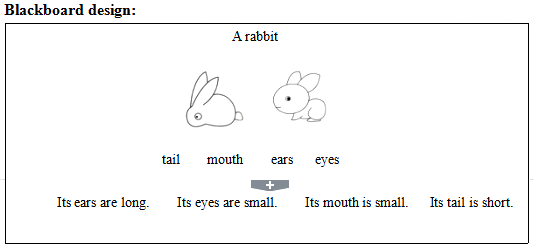 答案:解析:暂无解析
答案:解析:暂无解析 -
第7题:
共用题干
Teaching and Learning
Many teachers believe that the responsibilities for learning lie with the student.If a long reading assign-
ment is given,instructors expect students to be__________(51)with the information in the reading even if
they do not discuss it in class or__________(52)an examination.The ideal student is________(53)to
be one who is motivated to learn for the sake of learning,not the one interested only in getting high
___________(54).Sometimes homework is returned with brief written____________(55)but without a
grade.Even if a grade is not given,the student is___________(56)for learning the material assigned.
When research is_________(57),the professor expects the student to take it actively and to complete it
with minimum___________(58).It is the student's responsibility to find books,magazines,and articles in
the library.Professors do not have the time to__________(59)how a university library works;they expect
students to exhaust the___________(60)resources in the library.Professors will help students who need it,
_________(61)prefer that their students should not be too __________(62)on them.In the United
States professors have many other___________(63)besides teaching,such as administrative or research
work.Therefore,the time that a professor can spend__________(64)a student outside of class is limited.
if a student has problems with classroom work,the student should either__________(65)a professor
during office hours or make an appointment._________(61)
A:but
B:even
C:thus
D:and答案:A解析:be familiar with固定搭配,意思是“熟悉······”,符合句意。careful仔细的,小心的;happy 幸福的,高兴的;pleased高兴的,喜欢的;乐意做某事。
take an examination固定搭配,意思是“参加考试”,符合句意。
be considered to是固定搭配,意思是“被认为是”,符合句意。test测试,测验;recognize 认出,辨认出;assess评价,评定。
结合上文,该句意思是:理想的学生是为了学习知识而学习的,而不是为了获得高分而 学习的。grade意思是“成绩,分数”,符合句意。level水平,水准;degree度,度数;hope希望, 期望。
根据上下文,该句意思是:(返回的作业上)写有简单的评语但没有分数。comment意思 是“意见,评论”,符合句意。task工作,任务;declaration重要声明,宣言;question问题。
be responsible for是固定搭配,意思是“对······负责,承担责任”。anxious焦虑的,不安 的,担心的;concerned有关的,有牵连的;eager热切的,渴望的。
assign意思是“分配,指派”,符合句意。complete结束,完成;design设计;learn学习, 学会。
该句意思是:当研究内容分配下来以后,教授希望学生积极去做并且是在花费最少的 指导下完成。guidance意思是“指导,引导”,符合句意。requirement必需品,要求的事物;effort 力气,精力;evidence证据,证明。
该句意思是:教授们没有时间来解释大学图书馆是怎样运作的。explain意思是“解释, 说明”,符合句意。wonder对(某事)感到疑惑;想要知道;inquire询问,打听;speculate猜测, 推测。
reference意思是“参考,参照”,reference resources是“参考来源”的意思,符合句意。 inner内部的;personal亲自的,亲身的;natural正常的,平常的。
联系上下文,这里应该填一个表示转折的连接词,but符合句意。
dependent on意思是“依赖,依靠”,符合句意。keen感兴趣的,渴望的;energetic充满活 力的,精力充沛的;active积极的,活跃的。
该句意思是:在美国,教授们除了教学之外,还有许多其他的任务,比如管理方面或研 究方面的工作。duty意思是“责任,义务”,符合句意。opportunity机会;preference偏爱,偏好; point想法;某一事实。
结合上句意思,本句意思应该是:因此,在课堂之外一个教授能够跟学生在一起的时间 是有限的。spend with sb.意思是“花时间和某人在一起”,符合句意。
approach意思是“接近”,符合句意。trouble麻烦(某人),给(某人)添麻烦;select挑选, 选择;catch抓住。 -
第8题:
单选题When students are asked to find out the changes of their hometown and make a plan for an exhibition,which type of the following grouping methods is mostly recommended?AWhole class work.
BGroup work.
CPair work.
DIndividual work.
正确答案: B解析: -
第9题:
单选题About principles of teaching reading, which description is wrong?AThe selected texts and attached tasks should be accessible to the students.
BTasks should be given after reading.
CTasks should help develop students' reading skills rather than test their reading comprehension.
DThe teacher should provide enough guidance and assistance at the beginning.
正确答案: A解析: -
第10题:
根据下面资料,回答
Reading aloud and silent reading are two different types of reading practice. Each has a function in the teaching of reading and should not be 16 by the other. However, we need to be aware when we should use them. When we 17 teaching reading or developing reading skills, we are mostly referring to silent reading. To develop 18 readers in a foreign language, silent reading activities must be given enough 19 and time in class with the proper guidance from the 20 . Reading aloud also has its particular 21 for our students who are learning English as a foreign language. 22 can help them acquire good pronunciation and intonation, 23 them with new words and the stress patterns of English, help 24 their eontidenee in speaking the language. Therefore, opportunities should be 25 for students to read aloud only after they have comprehended the text 26 before comprehension can be very 27 and it can easily destroy their self-confidence. With 28 reading, it sets up a poor reading model for other students as well. It is 29 that we first help students learn the text through 30 reading activities and then with comprehension we give our students practice by using an audio tape to 31 a good model for practicing reading aloud. With adequate 32 , we may ask the students to read aloud to the whole class to 33 their motivation and confidence. By asking the students to read aloud, it is also a good chance for the teacher to get 34 on the students′ comprehension as we can notice 35 there are wrong pauses or mispronounced words which indicate possible difficulties or misunderstanding of the text.
第(17)题选A.work out
B.run into
C.talk about
D.take on答案:C解析:考查短语辨析。句意为“当我们________阅读教学或发展阅读技能时,我们多数指的是默读”。workout“解决,算出”,run into“遇到,陷入”,talk about“谈论”,take on“承担,呈现”,只有C项符合题意。 -
第11题:
根据下面资料,回答
Reading aloud and silent reading are two different types of reading practice. Each has a function in the teaching of reading and should not be 16 by the other. However, we need to be aware when we should use them. When we 17 teaching reading or developing reading skills, we are mostly referring to silent reading. To develop 18 readers in a foreign language, silent reading activities must be given enough 19 and time in class with the proper guidance from the 20 . Reading aloud also has its particular 21 for our students who are learning English as a foreign language. 22 can help them acquire good pronunciation and intonation, 23 them with new words and the stress patterns of English, help 24 their eontidenee in speaking the language. Therefore, opportunities should be 25 for students to read aloud only after they have comprehended the text 26 before comprehension can be very 27 and it can easily destroy their self-confidence. With 28 reading, it sets up a poor reading model for other students as well. It is 29 that we first help students learn the text through 30 reading activities and then with comprehension we give our students practice by using an audio tape to 31 a good model for practicing reading aloud. With adequate 32 , we may ask the students to read aloud to the whole class to 33 their motivation and confidence. By asking the students to read aloud, it is also a good chance for the teacher to get 34 on the students′ comprehension as we can notice 35 there are wrong pauses or mispronounced words which indicate possible difficulties or misunderstanding of the text.
第(24)题选A.go through
B.build up
C.show off
D.wipe out答案:B解析:考查短语辨析。go through“检查;完成”,buildup“逐步建立;增进”,show off"‘炫耀,卖弄”,wipe out“扫除:歼灭”。根据语境可知是帮助学生建立学英语的自信心,故选B。 -
第12题:
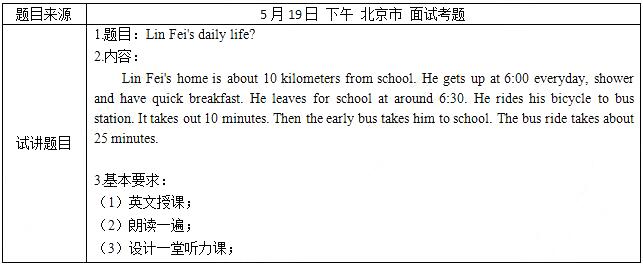
二、考题解析
【教案】
Teaching Aims:
Knowledge aim: Students will be able to describe their daily life and acquire some knowledge about listening strategies.题目来源于考生回忆
Ability aim: Students can obtain the main idea quickly from the listening material and develop the ability of grasping detail information.
Emotional aim: Students can foster the interest and desire of learning English, and be fond of taking part in kinds of practical activities.
Teaching Key Points:
Students can get the main idea and useful information from the listening material.
Teaching Difficult Points:
Students can apply these skills in their listening and apply these expression in their daily communication.
Teaching Methods:
Communicative teaching method, task-based teaching method, audio-lingual teaching method.
Teaching Aids:题目来源于考生回忆
PPT, Blackboard, recorder and so on
Teaching Procedures:
Step 1: Warming up
1.Greetings
2.Sing an English song It' my life, invite the whole students to clap when singing together and lead to the topic.
Step 2: Pre-listening
1.Free talk: Give students three minutes to talk about their own daily life and invite them to share it.
2.Prediction: Let students work in pairs and ask them to predict Lin Fei's daily life.
Step 3: While-listening
1. Listen to the tape for the first time and ask them when Lin Fei gets up and when he goes to school, then let students to share answers.题目来源于考生回忆
2.Listen to the tape for the second time and ask them to fill in the chart, then invite them to share their answers.
Step 4: Production
1.Retelling: Ask students to retell Lin Fei's daily life with the help of the chat in their own words, and teacher will give them 3 minutes to prepare it and 3 minutes later, invite some students to share their retelling in the front.
2.Survey: Let students discuss their own daily life in the group of four and make a report in the form of chart. 8 minutes later teacher invites some groups to share the result of their reports.
Step 5: Summary & Homework
Summary : Invite a little teacher to help teacher make a summary of this class.
Homework: Let students introduce their daily life to their parents and make a share in the next class.
Blackboard design:
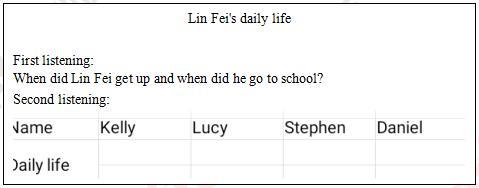 答案:解析:暂无解析
答案:解析:暂无解析 -
第13题:
初中英语?阅读
一、考题回顾

二、考题解析
【教案】
Teaching aims:
Knowledge aim:
Students will grasp and understand the main and detailed information of the passage.
Ability aim:
Students will improve their reading and speaking skills.
Emotional aim:
Students will foster the interest and desire of learning English and take part in speaking activities actively.
Key and difficult point:
Key Point: Students will totally understand the content of the passage.
Difficult Point: Students will foster the interest of learning English, and take part in speaking activities.
Teaching procedure:
Step 1: Warming-up
1. Greetings.
2. Show students pictures about different types of transportation and naturally lead to today’s topic.
Step 2: Pre-reading
1. Ask students two questions and some volunteers will be invited to share their answers.
Q1: How do you come to school?
Q2: How do your parents go to work?
2. Ask students to predict the main idea of the passage based on the above discussion and pictures on the screen.
Step 3: While-reading
1st reading: Ask students to read the passage for the first time and check their prediction. Besides, they need to find out which countries are mentioned in the passage and circle them.
2nd reading: Ask students to read the passage for the second time and complete the following chart. Some students will be invited to finish it on the blackboard.

Step4: Post-reading
Discussion: ask students to discuss the advantages and disadvantages of different modes of transportation. Four students in a group, after five minutes, some groups are supposed to show their results.
Step5: Summary and Homework
Summary: ask a student to conclude the content of the lesson and summarize with the whole class.
Homework: ask students to investigate their friends’ way of going to school and find some interesting ways of transportation on the Internet.
Blackboard design:
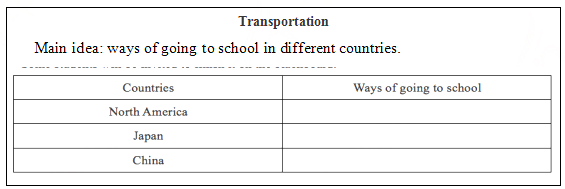
1. How to improve students’ reading and speaking ability in your class?
2. How did you evaluate the performance of students in the class?答案:解析:1.
It is very important to improve students’ reading and speaking abilities. In my class, I take three specific steps to improve their reading and speaking abilities. Firstly, before reading the article, I ask the students to guess the main idea of the article according to my questions and pictures on the screen. As you heard, this can not only exercise students’ guessing ability, but also help them read the passage with questions. In the while-reading part, I set two times of reading, namely extensive reading and intensive reading. Obviously, students’ scanning ability and the ability to grasp detailed information can be improved. It also helps them form good reading habits. As for speaking ability, I organize a discussion activity without standard answers. Students can express their views freely in groups. In this way, their reading and speaking abilities can be improved a lot.
2.
Students are under a stage of growing and developing. They are eager to be evaluated and encouraged by their teachers. At the same time, students are different, and their acceptance and abilities of learning are different. Therefore, in my class, I have adopted a variety of different evaluations. For the students who answered correctly, I would praise them directly, such as “excellent”, “you can find the answer so fast”. For those students who dare not answer questions or did not find out the answers, I just encouraged them and guided them to say the answers, and gave some encouraging comments, like “nice try!”, “you’ve made a great progress”. Also, some students made mistakes. In my class, instead of directly blaming the student for being wrong, I asked other students to help him/her and give them a proper evaluation. -
第14题:

二、考题解析
【教案】
Teaching Aims:
Knowledge aims:
(1) Students will master two difficult words,such as universal, unfamiliar.
(2) Students will learn knowledge about body language.
Ability aim: Students are able to understand the meaning of body language in their daily life and can improve the ability in scanning and skimming.
Emotional aim: Students can show their feelings with body language in reality.
Teaching Key Points:
Students can know the meaning of various body languages.
Teaching Difficult Points:
Students are able to express their feelings with body language in reality..
Teaching Methods:
Communicative teaching method, task-based teaching method, situational teaching method.
Teaching Aids:
PPT, Blackboard and so on
Teaching Procedures:
Step 1: Warming up
1.Greetings
2.Play a clip from a popular American TV series Lie to me (many body languages are shown in it), invite two students to talk about their feelings.
Step 2: Pre-reading
1.Let’s say. Lead students to talk about body languages that we usually see in our daily life.
Step 3: While-reading
1.Fast reading. Read the passage for the first time and ask students to summarize the main idea.
2.Careful reading. Read the passage for the second time with questions.
(1) How many body languages are mentioned in the passage when we meet others?
(2) what is the difference in different countries? Talk it in details.
Step 4: Post-reading
Divide all students into several groups and give them five minutes to discuss other body languages that we usually use. After that, invite three students to share.
Step 5: Summary & Homework
Summary : students look at the blackboard and summarize this class.
Homework:students surf the internet and collect more information about body language..
Blackboard design:
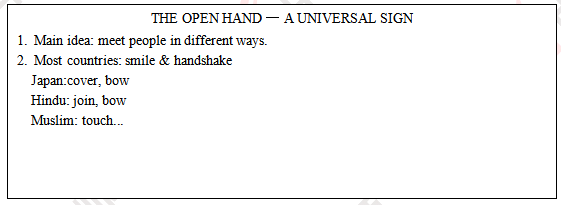 答案:解析:暂无解析
答案:解析:暂无解析 -
第15题:
共用题干
Teaching and Learning
Many teachers believe that the responsibilities for learning lie with the student.If a long reading assignment is given,instructors expect students to be familiar with the ______(1)in the reading even if they do not discuss it in class or take an examination.The ______(2) student is considered to be one who is motivated to learn for the sake of______(3) ,not the one interested only in getting high grades.Sometimes homework is returned ______(4) brief written comments but without a grade.
Even if a grade is not given,the student is ______(5) for learning the materi al assigned.When research is______(6), the professor expects the student to take it actively and to complete it with______(7) guidance.
It is the student's responsibility to find books,maga-zines,and articles in the library.Professors do not have the time to explain______(8) a university library works;they expect students______(9) graduate students to exhaust the reference______(10) in the library.Professors will help students who need it,but______(11) that their students should not be______(12)dependent on them.In the United States professors have many other duties______(13)teaching,such as administrative or research work.Therefore, the time that a professor can spend with a student outside of class is______(14).
If a student has problems with classroom work,the student should either______(15)a professor during office hours or make an appointment.1._________
A:suggestion
B:context
C:abstract
D:information答案:D解析:综合第一句的大意,只有D选项“信息”填在这里恰当,A项“提议,暗示”,B 项“语境,上下文”,C项“摘要”均不符合句意。
此句大意为“有理想的学生是为了学习而学习”,只有ideal最符合要求,故选B。
本文讲的是与学生学习相关的内容,A,B,D项均不合文意及句意,故排除。
此处要区分几个介词的含义,be returned with一般有“带着……回来”之意,此句意为“有时,被发回来的作业上只有简短的评价,并无分数”。be returned by意为“被……带回来”,而for,in于此搭配不当,所以答案选D。
be responsible for是固定搭配,表示“对……负责任”。其他选项放在此处都不合上下文含意。
此句意思是“当选定了一项研究课题时,教授们期望学生积极对待”。A和 D不合题意,最大的干扰项B意思为“分配,分布”,一般指一个整体被分散给许多个体,与之相比,C选项更为合适。
老师肯定希望学生能够在尽可能少的指导下完成研究。只有B选项意为 “最小的”,为正确答案。
首先排除B选项,因为此处需要一个关系副词充当宾语从句的状语,而 what是关系代词,之后要看整句的意思,“教授们没有时间去给学生解释一个大学图书馆是怎样运作的”。A和C虽然符合语法要求,但放此处意思不通,故选D。
A项“尤其”,B项“本质上”,C项“明显地”,D项“很少地,难得”。此处强调研究生,A选项较为合适。
此句意为“教授们期望学生,尤其是研究生阅尽图书馆中的文献资源”。A 项意为“选集”,B项为“集合”,两者一般都指文学作品的“集合”,而此处是学术界的文献。C 与D选项都有“来源,源头”的意思,但D选项侧重于“起源,开端”,C项更侧重于“原始资料”, 所以C项为正确答案。
根据下文意思,A和B选项可直接排除,教授们肯定是喜欢学生不依赖他们。D选项的含义比C选项更递进了一步,符合题意,故选D。
dependent是形容词,前面不能与such, much搭配,D选项more放在此处构成比较级,但前文并无原级与之相比较,因此只剩下A为答案,此句意为“教授们愿意帮助那些需要帮助的学生,但更希望学生不要太过依赖他们”。
此题重点在于区分三个有“除……之外”含义的介词。A选项一般翻译成 “而不是,并不是”,B选项意为“除去……之外”,D选项意为“除去……之外还……”,此句意思为“美国的教授除了教书之外还有许多其他的职责”,故D为答案。
根据上文含义,一个教授能花在学生身上的时间一定是有限的,A,C,D项不合题意,直接排除,B选项为正确答案。
此题还是承接上文含义,正因为教授时间有限,因此学生若想与之沟通,定要等教授在学校的时候,或是提前约好。C选项意为“接近,靠近”,为正确答案,A项“问候”, B项“使……厌恶”,D项“依附,伴随,添加”,意思均与文意不符。 -
第16题:
单选题When students are given the structure in an authentic or near authentic context and are asked to work out the rule for themselves, what kind of method their teacher is using?ADeductive grammar teaching.
BInductive grammar teaching.
CTraditional grammar teaching.
DCommunicative teaching.
正确答案: B解析: -
第17题:
单选题About principles of teaching reading, which description is wrong?AThe selected texts and attached tasks should be accessible to the students.
BTasks should be given after reading.
CTasks should help develop students' reading skills rather than test their reading compre-hension.
DThe teacher should provide enough guidance and assistance at the beginning.
正确答案: C解析:
